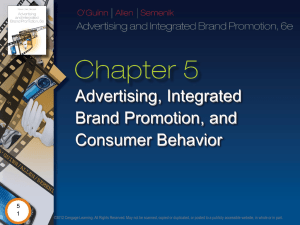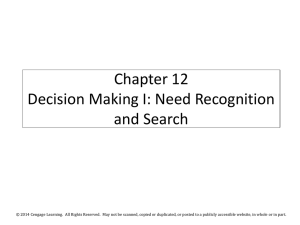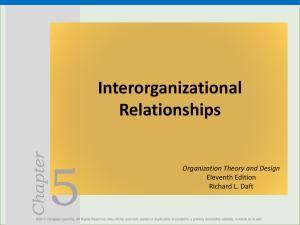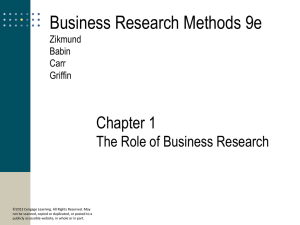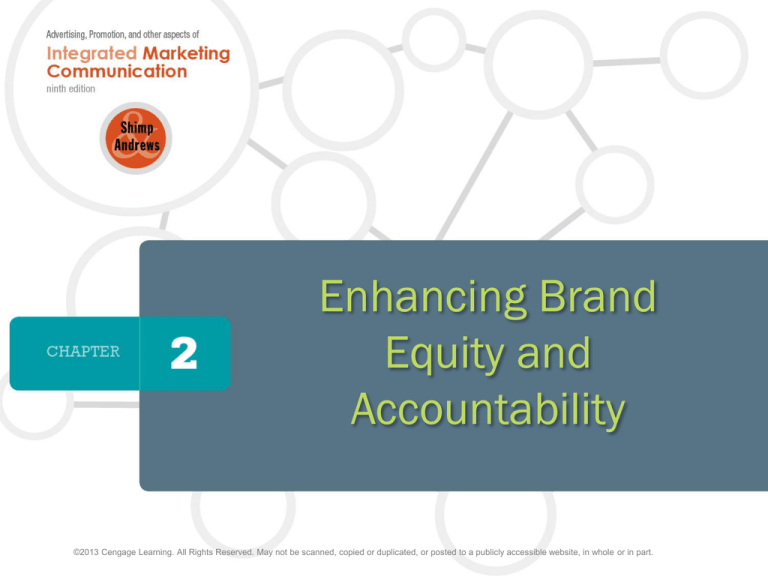
1
Enhancing Brand
Equity and
Accountability
©2013 Cengage Learning. All Rights Reserved. May not be scanned, copied or duplicated, or posted to a publicly accessible website, in whole or in part.
Chapter Objectives
After reading this chapter you should be able to:
1. Explain the concept of brand equity from both the
company’s and the customer’s perspectives.
2. What are some of the positive outcomes that result
from enhancing brand equity?
3. Describe the different models of brand equity from
the customer’s perspective.
4. Understand how marcom efforts must influence
behavior and achieve financial accountability.
©2013 Cengage Learning. All Rights Reserved. May not be scanned, copied or duplicated, or posted to a publicly accessible website, in whole or in part.
2
Are There Too Many Social Media Brands?
©2013 Cengage Learning. All Rights Reserved. May not be scanned, copied or duplicated, or posted to a publicly accessible website, in whole or in part.
3
Which Brand Is “Best”?
(Measures are important!)
1. Harris Interactive Poll (2400 adults)
• “Which three brands do you consider to be the best?”
• [2007 – Coca-Cola, Sony, Toyota]
2. Harris Interactive Brand Equity (EquiTrend) Study (25,000 adults)
• Familiarity, quality, purchase considerations, brand expectations,
distinctiveness, trust
• [2008 – Heinz, M&Ms, Hershey’s; 2010 – Target, Nintendo, M&Ms]
3. Interbrand’s “Best Global Brands”
• Brand sales as a % of total company sales
• Earnings (profits) for a brand
• NPV of the brand earnings, discounted by interest rates, risk, market
leadership, stability and global reach
• [2007 – Coca-Cola, Microsoft, IBM; 2010 – IMB #2]
4. Young & Rubicam’s Brand Asset Valuator (200,000 adults)
• Brand strength: differentiation, relevance
Brand
esteem,
©2013•Cengage
Learning. stature:
All Rights Reserved.
May not beknowledge
scanned, copied or duplicated, or posted to a publicly accessible website, in whole or in part.
4
Brand Defined
Brand
A name, term, sign, symbol, or design, or a
combination of them intended to identify the
goods and services of one seller or group of
sellers and to differentiate them from those of
the competition.
©2013 Cengage Learning. All Rights Reserved. May not be scanned, copied or duplicated, or posted to a publicly accessible website, in whole or in part.
5
Definition of Brand Equity
Brand Equity
the goodwill (equity) that an
established brand has built
up over its existence.
©2013 Cengage Learning. All Rights Reserved. May not be scanned, copied or duplicated, or posted to a publicly accessible website, in whole or in part.
6
As Brand Equity Increases…
• A higher market share is achieved
• Brand loyalty increases
• Premium prices can be charged
• The brand earns a revenue premium
©2013 Cengage Learning. All Rights Reserved. May not be scanned, copied or duplicated, or posted to a publicly accessible website, in whole or in part.
7
Revenue Premium
• The revenue differential between a
branded item and a corresponding
private-labeled item.
Revenue premium=
(volumeb)(priceb)-(volumepl)(pricepl)
©2013 Cengage Learning. All Rights Reserved. May not be scanned, copied or duplicated, or posted to a publicly accessible website, in whole or in part.
8
Children’s Taste Preferences
©2013 Cengage Learning. All Rights Reserved. May not be scanned, copied or duplicated, or posted to a publicly accessible website, in whole or in part.
9
Young & Rubicam’s “Brand Asset Valuator”
and Creating Strong Brands
• Methodology:
•
•
•
•
Interviews with over 200,000 consumers
40 countries
19,000 brands
40 measurement scales
• “DREK” sequence (measures of brand equity):
• differentiation -> relevance -> esteem -> knowledge
• Power Grid:
• brand strength (differentiation, relevance)
• brand stature (esteem, knowledge)
• Brand Development Cycle
©2013 Cengage Learning. All Rights Reserved. May not be scanned, copied or duplicated, or posted to a publicly accessible website, in whole or in part.
10
Figure 2.1: Power Grid and Brand
Development Cycle
©2013 Cengage Learning. All Rights Reserved. May not be scanned, copied or duplicated, or posted to a publicly accessible website, in whole or in part.
11
Figure: 2.2: A Customer-Based Perspective on
Brand Equity
©2013 Cengage Learning. All Rights Reserved. May not be scanned, copied or duplicated, or posted to a publicly accessible website, in whole or in part.
12
Figure 2.3: Brands and Their Management
©2013 Cengage Learning. All Rights Reserved. May not be scanned, copied or duplicated, or posted to a publicly accessible website, in whole or in part.
13
The Brand Concept and Brand Concept
Management
• Brand concept: the specific meaning that brand
managers create and communicate to the target
market.
• this is accomplished by appeals to functional, symbolic,
and experiential needs
• Brand concept management: the analysis, planning,
implementation, and control of a brand concept
throughout the life of a brand.
©2013 Cengage Learning. All Rights Reserved. May not be scanned, copied or duplicated, or posted to a publicly accessible website, in whole or in part.
14
How Brand Concepts Can Be Developed
• Functional needs (solving problems): products that
attempt to fulfill the consumer’s consumptionrelated problems
• Symbolic needs (associating the brand with
symbolic objects): directed at consumers’ desire for
self-enhancement, role position, group membership,
and belongingness
• Experiential needs (sensory pleasures, personal
experience): products that provide sensory pleasure,
variety, and/or cognitive stimulation.
©2013 Cengage Learning. All Rights Reserved. May not be scanned, copied or duplicated, or posted to a publicly accessible website, in whole or in part.
15
Dimensions of Brand Personalities
• Sincerity (e.g., Disney)
• Excitement (e.g., Hummer)
• Competence (e.g., Toyota)
• Sophistication (e.g., Rolex, Cartier)
• Ruggedness (e.g., Timberland boots)
©2013 Cengage Learning. All Rights Reserved. May not be scanned, copied or duplicated, or posted to a publicly accessible website, in whole or in part.
16
Illustration of a Sincere Brand--Disney
©2013 Cengage Learning. All Rights Reserved. May not be scanned, copied or duplicated, or posted to a publicly accessible website, in whole or in part.
17
Illustration of a Sophisticated Brand
©2013 Cengage Learning. All Rights Reserved. May not be scanned, copied or duplicated, or posted to a publicly accessible website, in whole or in part.
18
Illustration of a Rugged Brand
©2013 Cengage Learning. All Rights Reserved. May not be scanned, copied or duplicated, or posted to a publicly accessible website, in whole or in part.
19
Three General Ways Brand Equity is Enhanced
• Allow brand to speak-for-itself
• Create message-driven associations
• Leveraging current meanings or
associations
©2013 Cengage Learning. All Rights Reserved. May not be scanned, copied or duplicated, or posted to a publicly accessible website, in whole or in part.
20
Figure 2.5: Leveraging Brand Meaning from
Various Sources
©2013 Cengage Learning. All Rights Reserved. May not be scanned, copied or duplicated, or posted to a publicly accessible website, in whole or in part.
21
Co-branding and Ingredient Branding
• Co-branding
• A partnership between two brands
• Ingredient branding
• Inclusion of one brand within the other
©2013 Cengage Learning. All Rights Reserved. May not be scanned, copied or duplicated, or posted to a publicly accessible website, in whole or in part.
22
What Benefits Result from Enhancing Brand
Equity?
• Increased consumer loyalty
• Long-term growth and profitability for
the brand
• Maintain brand differentiation from
competitive offerings
• Insulate brand from price competition
©2013 Cengage Learning. All Rights Reserved. May not be scanned, copied or duplicated, or posted to a publicly accessible website, in whole or in part.
23
Measuring World-Class Brands
Evaluating
World-Class Brands
Quality
Salience
Equity
©2013 Cengage Learning. All Rights Reserved. May not be scanned, copied or duplicated, or posted to a publicly accessible website, in whole or in part.
24
Measuring World-Class Brands
• Quality: score ranging from 0 to 10 (unacceptable/
poor to outstanding/ extraordinary)
• Salience: score ranging from 0 to 100 (percentage of
people who feel sufficiently well informed about a
brand to rate it)
• Equity: score ranging from 0 to 100 (determined by
multiplying the quality and salience scores and
dividing the product by 10)
©2013 Cengage Learning. All Rights Reserved. May not be scanned, copied or duplicated, or posted to a publicly accessible website, in whole or in part.
25
Equitrend’s Top-Ten World-Class Brands
Overall (2009)
©2013 Cengage Learning. All Rights Reserved. May not be scanned, copied or duplicated, or posted to a publicly accessible website, in whole or in part.
26
Interbrand’s Top 20 Global Brands (2010)
©2013 Cengage Learning. All Rights Reserved. May not be scanned, copied or duplicated, or posted to a publicly accessible website, in whole or in part.
27
Affecting Behavior and Achieving Marcom
Accountability
• Creating brand awareness and boosting
brand image serve little positive effect
unless individuals make purchases or
engage in some other form of desired
behavior.
©2013 Cengage Learning. All Rights Reserved. May not be scanned, copied or duplicated, or posted to a publicly accessible website, in whole or in part.
28
ROMI
• The effect of marcom, or of its specific
elements such as advertising, can be gauged in
terms of whether it generates a reasonable
revenue return on the marcom investment.
• In marketing, return on investment is called
return on marketing investment (ROMI)
• (In accounting, ROI = net income/avg. O.E.)
©2013 Cengage Learning. All Rights Reserved. May not be scanned, copied or duplicated, or posted to a publicly accessible website, in whole or in part.
29
Difficulty of Measuring Marcom
Effectiveness
• Choosing a Metric
• Gaining Agreement
• Collecting Accurate Data
• Calibrating Special Effects
©2013 Cengage Learning. All Rights Reserved. May not be scanned, copied or duplicated, or posted to a publicly accessible website, in whole or in part.
30
Choosing a Metric
• Change in brand awareness
• Improved consumer attitude toward the
brand
• Increased purchase intentions
• Larger sales volume (e.g., via scanner
data; marketing mix models)
©2013 Cengage Learning. All Rights Reserved. May not be scanned, copied or duplicated, or posted to a publicly accessible website, in whole or in part.
31
Gaining Agreement
Finance
Departments’
Measures of Success:
Marketing
Departments’
Measures of Success:
• Discounted cash flows
• Net present values of
investment decisions
• Measures of brand
awareness, image,
equity, sales, …
©2013 Cengage Learning. All Rights Reserved. May not be scanned, copied or duplicated, or posted to a publicly accessible website, in whole or in part.
32
Collecting Accurate Data and Calibrating
Special Effects
• What exact sales figures should be used
to calculate sales?
• How much relative effect does each
program element have on sales volume
compared to the effect of other elements?
©2013 Cengage Learning. All Rights Reserved. May not be scanned, copied or duplicated, or posted to a publicly accessible website, in whole or in part.
33
Marketing-Mix Modeling – Example
©2013 Cengage Learning. All Rights Reserved. May not be scanned, copied or duplicated, or posted to a publicly accessible website, in whole or in part.
34



